In project management, the project charter is a key document that management creates to officially start the project. This document is the basis of the project and is referred to throughout the project lifecycle.
The project charter is a part of the initial business documents; other documents are the business case and benefits management plan.
The Project Management Institute (PMI) insists the project must have a charter.
In today’s post, I will explain the project charter and provide you with an example and template that you can use for your project.
What is a Project Charter?
According to the PMBOK Guide, “A project charter is a document issued by the project initiator or sponsor that formally authorizes the existence of a project and provides the project manager with authority to apply organizational resources to project activities.”
A project charter establishes the project, names the project manager, and gives them the authority and funding required to execute it. It induces high-level project details.
The project charter is signed by someone external to the project who has access to funds and resources to complete the project. This person can be senior management, the PMO, etc.
Although the project manager does not create or sign the project charter, they can help the project sponsor or management develop the project charter.
In project management, the charter also applies to program and portfolio management with the same purpose – authorization.
Before starting the project, the sponsor conducts a feasibility study, a cost-benefit analysis, and a review of the benefits management plan. If the project fits their long-term goal, they will proceed.
The project charter defines the project and guides stakeholders. Changes to the project charter are rare; only the sponsor or top management can do so.
A project is often known as a “Project Initiation Document (PID)” or a “Project Definition Document.”
Project Charter Template
A project charter template is shown below.
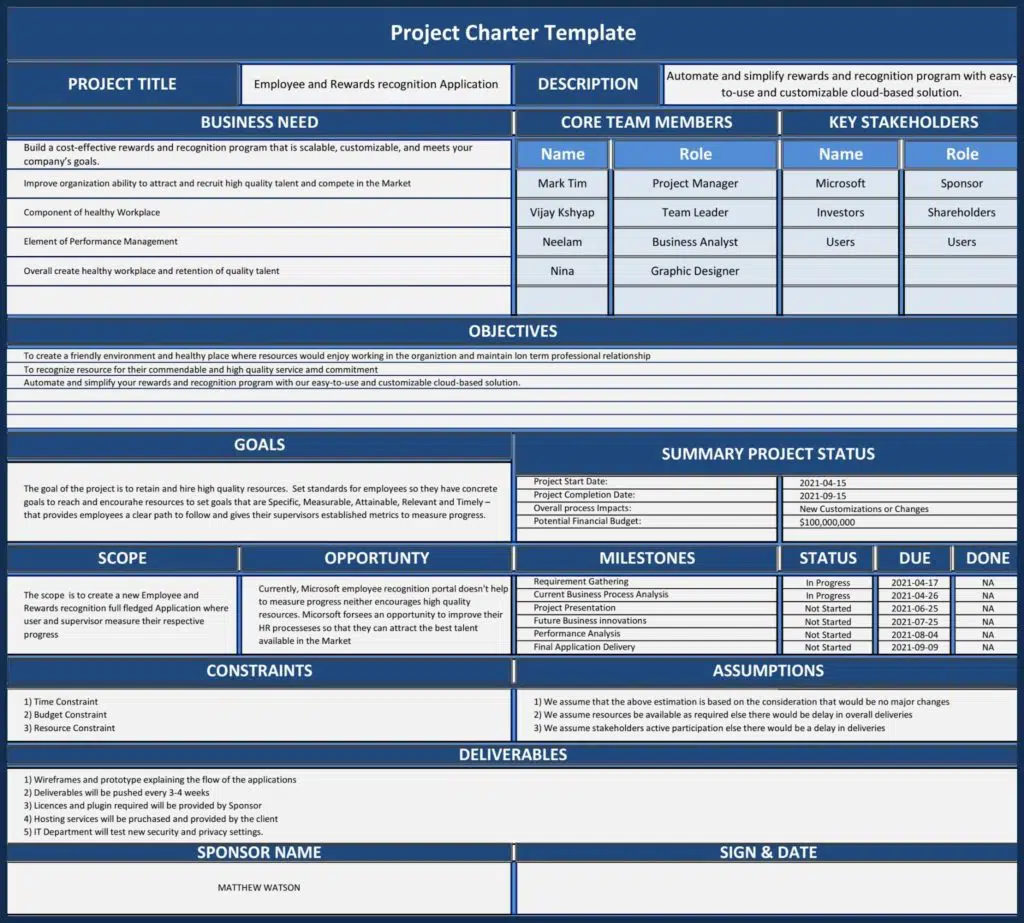
A project charter has the following elements:
- Core Team Members: This lists the key team members, including the project manager.
- Project Summary: This gives an overview of the project (e.g., start date, estimated completion date, and project benefits).
- Milestones: A project milestone is a significant point or event (e.g., a kick-off meeting, site mobilization, phase end, final report submission, deliverable completion, etc.). Milestones are listed alongside their due date.
- Opportunity: This is a problem-solution statement. What is the purpose of the project? What benefits will this project bring to the project sponsor?
- Goal: Goals are high-level vision statements that provide context for what the project will accomplish.
- Objective: While goals are visions, objectives are missions. These are measurable targets that the project aims to achieve. Objectives must be SMART (i.e., Specific, Measurable, Attainable, Realistic, and Time-Bound).
- Scope: This is the high-level scope of the project.
- Business Case: This justifies the project’s existence. It is usually developed after a feasibility study or cost-benefit analysis has been conducted.
- Constraints: These are limitations on the project objective (e.g., time, budget, scope, quality, etc.). As the project evolves, the constraints may change—especially for highly uncertain projects that use Agile approaches.
- Assumptions: These are conditions that are assumed to be true. They are recorded in the assumption log.
- Deliverables: Project deliverables are specific outcomes the project expects to achieve.
- Stakeholders: These are individuals, entities, or groups of individuals who are interested in the project or its output. A project charter contains the names of the key stakeholders (e.g., project sponsor, project manager, etc.).
Other components of the project charter are the project’s title and description, pre-assigned resources (i.e., people or resources who are assigned to the project before it formally begins), high-level project and product requirements, acceptance criteria, key risks, etc.
Finally, every project has a business justification, assigned budget, and duration, including start and end dates.
Let’s discuss the process used to create the project charter.
How to Write a Project Charter
A project charter development process is shown in the below image.
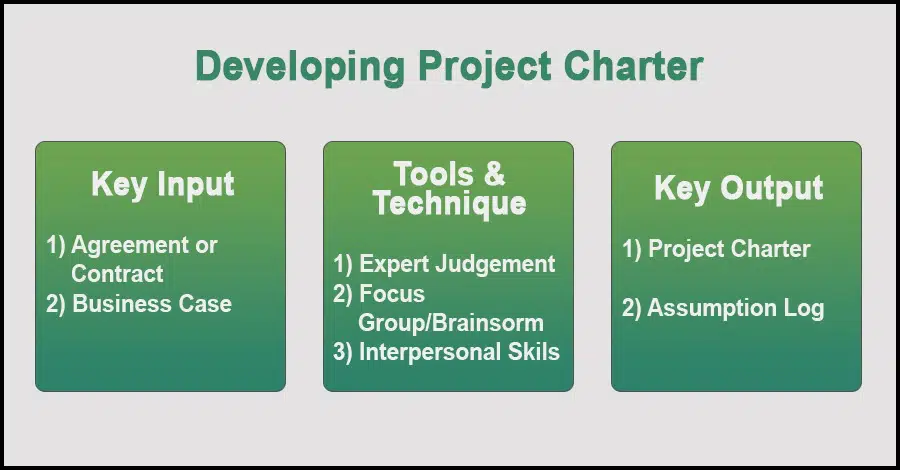
Input Required to Develop the Project Charter
The following is a basic description of the input elements:
Contracts or Agreements: You will need these documents if the project is the result of a contract or agreement.
Business Case: This outlines the project’s financial justification and cost-benefit analysis. The benefit-management plan describes how the client will benefit from the project’s deliverables.
Other input includes organizational policies, such as human resources policies (which can aid in the selection of project team members), health and safety policies (which can serve as a warning against approving projects that could seriously jeopardize the lives and health of project team members), security and confidentiality policies, and quality policies (which could include the cost of quality).
Tools and Techniques for Developing the Project Charter
Expert Judgment: This includes talking to specialists about the project charter. These are people or organizations with expertise in various aspects of project management. Their feedback will help create a solid project charter.
Focus Groups/Brainstorming Meetings: These will help gather ideas or data (e.g., project cost, duration, risks, milestones, stakeholder list, etc.). Brainstorming meetings can help the charter team produce ideas. Brainstorming is a relaxed, informal approach to problem-solving that uses lateral thinking. Although some ideas may sound strange, they should still be noted. A focus group takes a structured approach, and it usually involves subject-matter experts moderated by a facilitator.
The facilitator must elicit information by asking proper questions, checking responses, and developing new questions based on these responses. Meetings will provide a forum for discussion, planning, and other activities. To be productive, meetings must adhere to fundamental guidelines (e.g., timeliness, agenda, decorum, etc.). You may adopt a more facilitative strategy rather than a directive one. A successful meeting plan must unify all efforts to gather expert perspectives.
Interpersonal Skills: These skills will help drive the above activities. They cover communication, conflict resolution, team building, emotional intelligence, etc. All projects have one thing in common: their workforce. As such, they must lead with relational power rather than force. Additionally, they must innovate, influence, act morally, look to the future, question “what” and “why,” develop ideas, and concentrate on a unified vision, inspiration, and motivation.
Output
Project Charter: The project charter is a key output of this process. After the project charter is approved, the project manager can start the activities.
Assumption Log: Assumptions and constraints that are used to develop the project charter are recorded in the assumption log. The assumption log is updated throughout the project as assumptions change or become invalid.
Tips for Writing a Project Charter
The following tips can help you develop a project charter:
- Keep it Short and Clear: The project charter will provide high-level information, so keep it short and precise. Keep the number of sections to a minimum, organize the information well for easy referencing, and label each section.
- Make it a Collaborative Effort: Involve experts and key stakeholders in developing the project charter. It will make the project charter more robust.
- Use a Template: Every organization has a project-charter template. This is standard and acceptable. Using it will save time and get quick stakeholder buy-in.
Project Charter Example
Let’s see an example of a project charter.
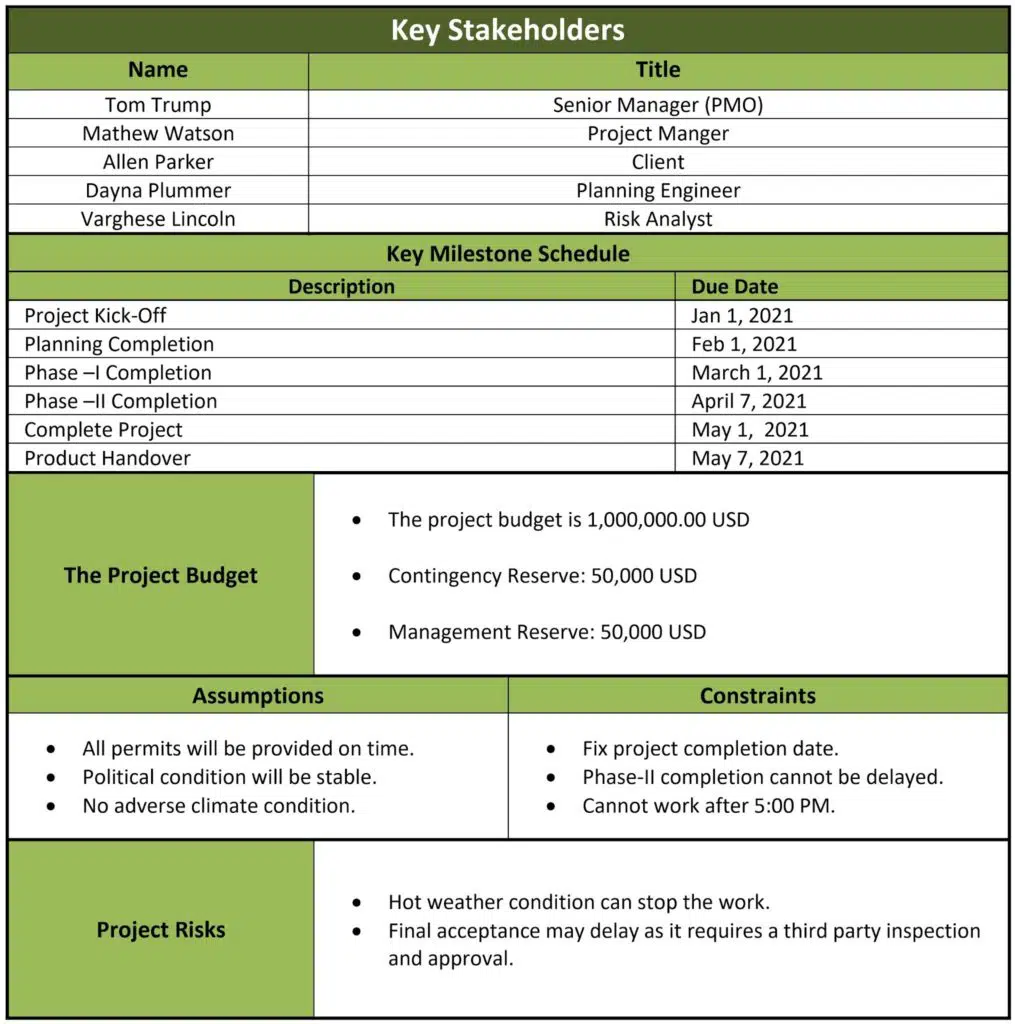
Project Charter Benefits
The following are the benefits of a project charter:
- It gives the project manager the authority to complete the project.
- It explains the project’s existence.
- It shows management’s support for the project.
- It defines the outcome.
- It aligns the project with the organization’s objectives.
- It gives team members a transparent reporting system.
- It helps avoid scope creep and gold plating.
- It helps avoid project disputes.
A project charter builds a solid foundation for the project. It provides a common understanding of the objectives.
Project Charter Vs Business Case
A business case provides reasons to proceed with the project. This document helps the project sponsor decide whether to proceed with the project.
This document provides the project’s benefits, risks, constraints, cost-benefit analysis, etc.
Project Charter Vs Memorandum of Agreement
The Memorandum of Agreement (MOA) is an agreement between the two parties. When a contractor gets a contract from a client, they both sign an MOA. This is a commercial and legally binding document; changes may only be made with the consent of both parties. An MOA is often a one—or two-page document.
On the other hand, a project charter is only signed by one side. Here, the project manager is chosen and given the responsibility to complete the project. The signing authority may change this document as necessary; it is not legally binding.
Project Charter Vs Project Plan
A project charter is a brief document. It is the project’s initial document, authorizes the project, and gives project managers the power to finish it.
After the project charter is signed, project plans are created. The scope management plan, quality management plan, risk management plan, procurement management plan, and stakeholder engagement plan are just a few of the many subsidiary plans that comprise a project plan.
A project plan may be hundreds or thousands of pages long. It offers all the information necessary to complete the project work.
Project Charter Vs Project Brief
A project brief is created after the project charter is signed, the project is started, and project management plans are developed.
A “project brief” provides a shorter version of the plans, so stakeholders can review it and grasp the planning process.
Project Charter FAQs
Now, let’s discuss some FAQs about the project charter.
#1. Who Signs the Project Charter?
PMP aspirants often get confused and think the project manager signs the charter.
Note that the project charter appoints a project manager. A person cannot appoint himself.
The sponsor, or someone from top management, signs the project charter. They are external stakeholders and have the authority to provide resources and support.
#2. Can a Project Have Multiple Project Charters?
One project charter is the norm for projects. Large, multi-phased projects, however, may have project charters for every stage. It is preferable to break a project into phases when the scope is too large to manage—for instance, a project to build a refinery.
#3. Who Keeps the Project Charter?
The project charter is an official controlled document. The project administrator or coordinator can keep a copy, which could also be stored for reference at the project management office.
Conclusion
The project charter gives project managers the authority, support, and funds required to complete the project. A project intends to solve a problem, but if launched incorrectly, it may fail and waste resources. A strong project charter will help the team successfully complete the project.
From the perspective of the PMP test, this subject is crucial. Therefore, fully comprehend it.

I am Mohammad Fahad Usmani, B.E. PMP, PMI-RMP. I have been blogging on project management topics since 2011. To date, thousands of professionals have passed the PMP exam using my resources.

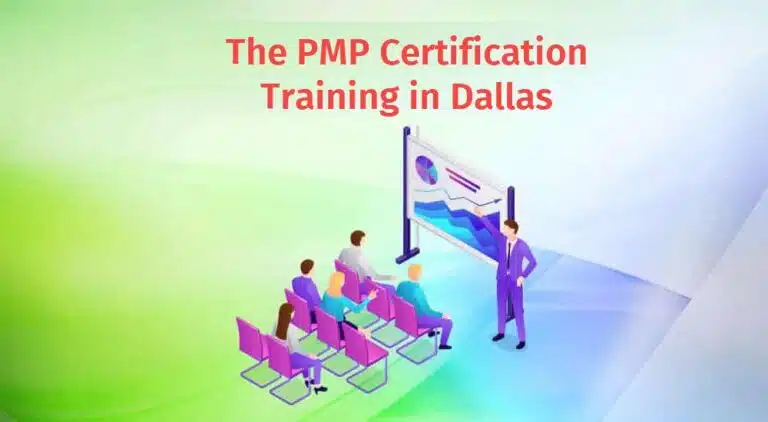
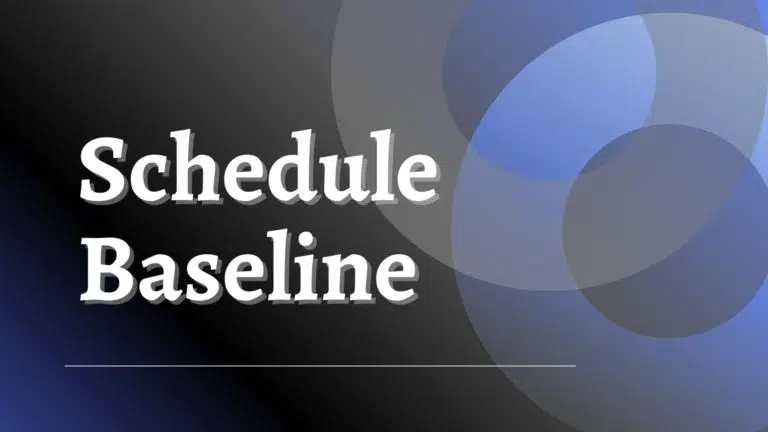
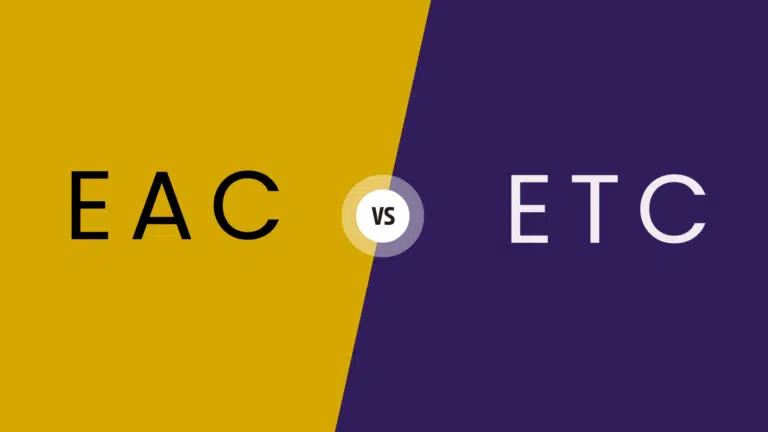
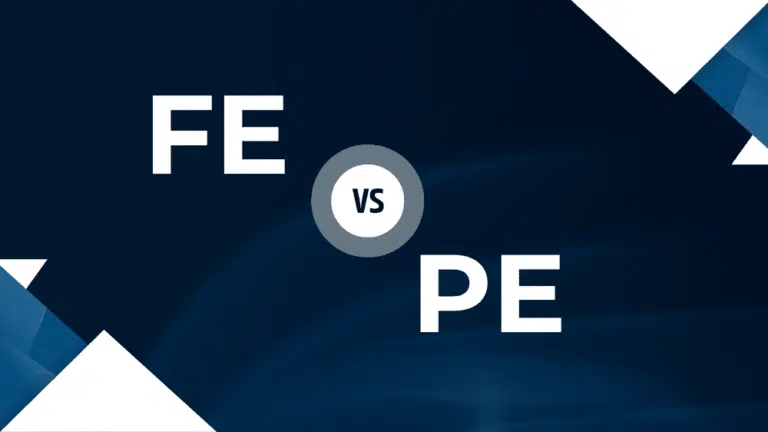
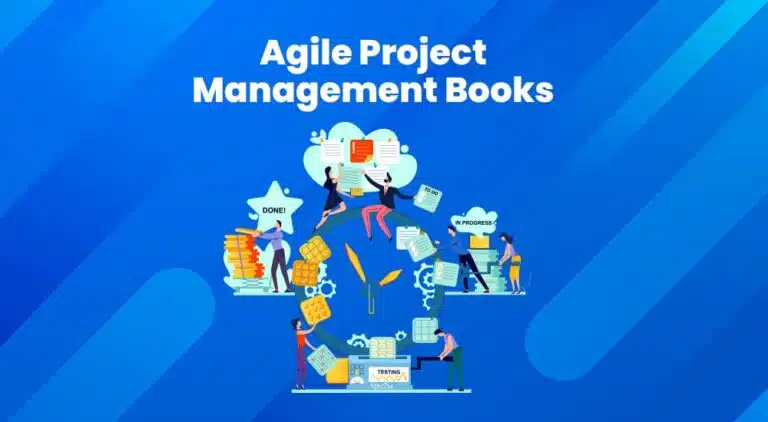
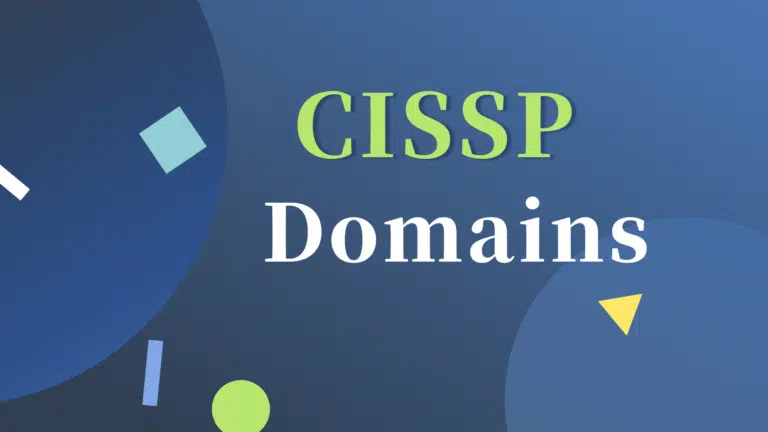
Well done, thanks.
very Helpful documets
Any way I could have access to these charter templates?
The project charter is a very important document so why doesn’t every project have one? How can we ensure this on our projects?